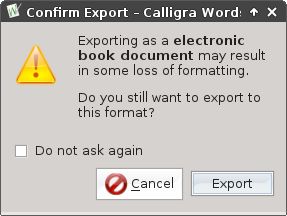Although it's fairly simple to code EPUB using an IDE or text editor like Bluefish, there's really no reason not to try excellent popular EPUB editor Sigil or extremely powerful ebook converter and manager, Calibre. Sigil is great for packaging your text (or XHTML) to EPUB while Calibre is perfect for working with other formats and testing compatibility with devices. If you want to focus on writing however and exporting directly to EPUB for Sigil or Calibre, then Calligra Words may be a good alternative to the numerous writing software available.
Why use Calligra Words?
There is a infinite amount of writing software available - from commercial products (Microsoft Word), plain text editors and note-taking applications (KeepNote, CherryTree), structured text editing (LyX), word processors (LibreOffice, Abiword), cloud services (Google Docs Writely), and distraction free editors (FocusWriter, WriteMonkey). Why use Calligra Words to write your potboiler?
1. Calligra Words exports directly to EPUB. LyX, a WYSIWYM word processor that uses LaTeX, is great but doesn't export directly to EPUB. Apache OpenOffice and the widely available LibreOffice both require plugins to export to EPUB and even then the results are far from perfect. Once you're done with your book in Calligra Words, you don't have to worry about copying and pasting text to Sigil later on - just open the EPUB file in Sigil and you're good to go for additional editing.

2. Distraction free writing. Some would-be authors prefer vanilla word processors without the extensive formatting options. Calligra Words is a basic text editor with the essentials for writing long books (TOC, citation, styles, spellcheck). Like distraction free writing applications like FocusWriter, you can just type to your hearts content without worrying about formatting.
3. Support for Google Docs, Microsoft Word, Wordperfect, and .ODT (an excellent open source format supported by many word processors).
Calligra Word Dockers
Calligra Words uses the Dockers interface found in all applications in the Calligra Office suite. Dockers is Calligra's answer to Microsoft Office's Ribbon and Adobe's floating palettes. The displayed Dockers can easily be moved and hidden (CTRL+H) at any time though it does take some getting used to. For Calligra Words, the number of dockers available is thankfully small so writers can just take out dockers for editing Shapes and creating vector paths.
There is a very shallow learning curve to using the Dockers. Click a docker to expand, click another docker to close and open another (there is always a docker open unless you hide all the dockers). Additional dockers are available by clicking Settings then Dockers, though most of them are unnecessary if you're a good writer and focus on prose rather than visuals. Text editing, Add Shape (for adding placeholders for images and text), and References are all the dockers a typical writer really needs.

I installed the Calligra Office Suite on my 10.1" ASUS EEEPC 1000H netbook running Fedora 18 Xfce and I first found the dockers awkward and intrusive, having been used to Office's Ribbon and LibreOffice's more conservative menus. The trick is to click the appropriate docker first before beginning a task. If you want to work with text, click Text Editing. If you want to insert an image, click Add Shape (which you use to click and drag to produce a frame). If you want to adjust the image's position, click the Basic Shape Manipulation docker. After a certain period, however, I found the tools were judiciously placed in the dockers and surprisingly convenient. That said, I would recommend Calligra Words installed on a KDE system rather than an Xfce desktop and on a 14" screen rather than a small one.
Text, shapes, and images
Calligra Words doesn't try to pretend to be an application that provides you with the ability to create shapes and objects on-the-fly. Instead, it focuses on letting you use image resources (vectors or bitmaps) from your own library. This leaves you to focus on just the text and occasionally inserting your own illustrations or photos. Two dockers, however, are curiously devoted for connecting objects and creating paths. Both are not nearly as useful as the Basic Shape Manipulation docker, which provides options for aligning objects.
Table of Contents, Citations and Bibliography
Anyone who has worked with bibliographies and table of contents in Adobe InDesign, Microsoft Word, and Adobe Framemaker know that TOCs, footnotes, and bibliographies can be pretty messy. I created a table of contents using a few old unedited blog posts I made and it was delightfully easy, as was adding footnotes, endnotes, and a bibliography. I was especially happy that inserting footnotes and endnotes was even more intuitive than LyX's admittedly confusing dialog windows.

Continued in Calligra Words and EPUB Part 2
















0 comments:
Post a Comment